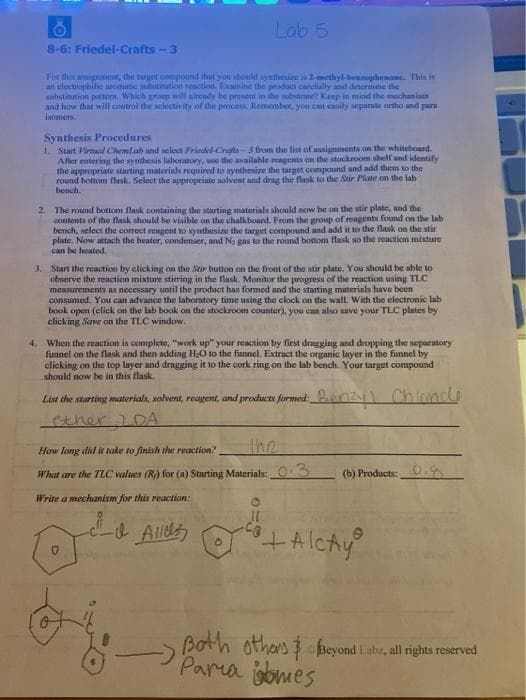Chapter20: Carboxylic Acids And Nitriles
Section20.SE: Something Extra
Problem 25MP: Acid-catalyzed hydrolysis of a nitrile to give a carboxylic acid occurs by initial protonation of...
Related questions
Question
Solve pls .. if u know

Transcribed Image Text:Lab 5
8-6: Friedel-Crafts-3
For this amignient, the turget compound that you sbould syathesite is 2-methyt-benophenone. This is
an electrophilie arcmatie, substitution resction Eaamine the prodact carefully and determine the
substination pattern. Which groep will aiready be present in the substrate Keep in mind the mechanism
and bow that will control the selectivity of the proces Remember, you can casily separate ortho and para
Isomers
Synthesis Procedures
1. Start Virtunl Chemlah and select Friedel-Crafts -3 from the list of assignments on the whiteboard.
Afler catering the synthesis laboratory, use the available reagents on the stockroom shelf and identify
the appropriate starting materials required to nynthesize the target compound and add them to the
round bottom flask. Select the appropriate solvent and drag the flask to the Stir Plate on the lab
bench.
2. The round bottom flask containing the starting materials should now be on the stir plate, and the
contents of the flask ahould be visible on the chalkboard. From the group of reagents found on the lab
bench, select the corect reagent to synthesize the target compound and add it to the flask on the stir
plate. Now attach the heater, condenser, and N: gas to the round bottom flask so the reaction mixture
can be heatod.
3. Start the reaction by clicking on the Stir button on the front of the stir plate. You should be able to
observe the reaction mixture stirring in the flask. Monitor the progress of the reaction using TLC
measurements as necessary until the product has formed and the starting muterials have been
consumed. You can advance the laborntory time using the clock on the wall. With the electronic lab
book open (elick on the lab book on the stockroom counter), you can also save your TLC plates by
clicking Save on the TLC window.
4. When the reaction is complete, "work up" your reaction by first dragging and dropping the separatory
funnel on the flask and then adding H:O to the funnel. Extract the organic layer in the funnel by
clicking on the top layer and dragging it to the cork ring on the lab bench. Your target compound
should now be in this flask.
List the starting materials, solvent, reagent, and products formed: enz Chionde
ether 1DA
How long did ir take to finish the reaction?
the
What are the TLC values (R) for (a) Starting Materials:O3
(b) Products:O.
Write a mechanism for this reaction:
d All
Both
othos3 Beyond Labr, all rights reserved
Para ibmes
Expert Solution
This question has been solved!
Explore an expertly crafted, step-by-step solution for a thorough understanding of key concepts.
Step by step
Solved in 2 steps with 1 images

Knowledge Booster
Learn more about
Need a deep-dive on the concept behind this application? Look no further. Learn more about this topic, chemistry and related others by exploring similar questions and additional content below.Recommended textbooks for you


Organic Chemistry
Chemistry
ISBN:
9781305580350
Author:
William H. Brown, Brent L. Iverson, Eric Anslyn, Christopher S. Foote
Publisher:
Cengage Learning


Organic Chemistry
Chemistry
ISBN:
9781305580350
Author:
William H. Brown, Brent L. Iverson, Eric Anslyn, Christopher S. Foote
Publisher:
Cengage Learning